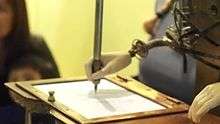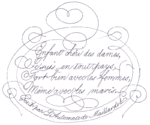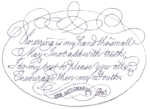
The "Draughtsman-Writer" automaton by Henri Maillardet

Maillardet's automaton is drawing a picture
Maillardet's automaton (or Draughtsman-Writer, sometime also known as Maelzel's Juvenile Artist or Juvenile Artist) is an automaton built in London circa 1800 by a Swiss mechanician, Henri Maillardet. It is currently part of the collections at The Franklin Institute in Philadelphia.
Acquisition
In November 1928 the Franklin Institute received the pieces of a brass machine. It came from the descendants of John Penn Brock, a family who knew that at some time it had been able to write and draw pictures. Having been in a fire, its restoration involved a considerable amount of work. The Brock family believed that the machine had been made in France by an inventor named Maelzel.
The original writing instrument, either a quill or a brush, was replaced with a stylographic fountain pen. Once repaired the automaton began to produce elaborate sketches and poems. In the border surrounding the final poem, the automaton wrote, "Ecrit par L'Automate de Maillardet", translating to "Written by the automaton of Maillardet".[1]
Travel exhibitions
During the early nineteenth century, Maillardet exhibited this automaton and other automata that he created throughout England, other countries in Europe as far as St. Petersburg, Russia.[2] The following is a partial list of known exhibitions of the Maillardet's automaton. The automaton was mostly known as the Juvenile Artist in those exhibitions:

The Automaton Exhibition at Gothic Hall in 1826. The Juvenile Artist was at the right.
- 1807: The exhibition at Mr. Wigley's Great Rooms in Spring Gardens, London included the Juvenile Artist.[3]
- 1821 – 1833: The automata of Maillardet were in the possession of a gentlemen named Mr Schmidt. He held an exhibition in London. The last public display in London was held in 1833 at New Gothic Hall, 7 Haymarket Street before the exhibition was on tour to St. Petersburg[4] where it disappeared along with other automata in the collection.[5]
- 1835: An exhibition in Boston under the showman Johann Nepomuk Maelzel included the Juvenile Artist automaton[6]
- 1835: The Juvenile Artist automaton was also traveled to Philadelphia in an exhibition at American Museum located then at the corner of Fifth and Chesnut Streets. The announcement for the event mentioned the success of Maelzel's exhibition in Boston. It also attributed the automata including the Juvenile Artist in the exhibition as "Maillardet's unrivalled mechanical and musical automata". The announcement was recorded as having Henri Maillardet, Johann Nepomuk Mälzel, and American Museum (Philadelphia, Pa.) as authors.[7]
- November 27, 1835 – January 16, 1836: Maelzel took Maillardet automaton including the Juvenile Artist along with his Chess Player to a tour in Washington, D.C.[8]
- Late 1836 – early 1837: The Juvenile Artist was among other automata presented at American Museum in New York during the Christmas and New Year exhibition.[9]
Museum collections
Amazing Machine
The Maillardet's automaton is a highlight of the Amazing Machine permanent exhibit at The Franklin Institute. The exhibition includes more than two dozen rarely displayed machines with exploded views of the machines to show their components such as gears, cams, pulleys and linkages.[10] The Maillardet's automaton is always on display but the staff operate it only a few times a year for public demonstrations.[11] The demonstrations show all seven drawings of the automaton as seen in the followings:
| Poems produced by Maillardet's automaton |
|---|
|
| Drawings produced by Maillardet's automaton |
|---|
|
Computer history
The pictures of Maillardet's automaton are among other artifacts in the collections of Computer History Museum in Mountain View, California. The museum has a collection of machines in pre-computer era. Particularly for Maillardet's, the museum highlights the use of its cams in similar function to read-only memory (ROM) of computer to store pre-defined data for retrieval at a later time. In Maillardet's automaton case, it stores motion data necessary to write a poem on paper.[12][13] It is believed to be the largest cam-based memory of any automaton of the era.[14] The information capacity of the automaton to hold 7 images within the machine was calculated to be 299,040 points, almost 300 kilobits of storage.[5]

Automaton drawing of Cupid on April 29, 1835 by Maelzel's Juvenile Artist
Maelzel's Juvenile Artist
The Massachusetts Historical Society holds a drawing created in 1835 by an automaton in the collections of papers and artwork of the Minot family. The drawing is untitled with a depiction of Cupid. The writing on the picture indicated that it was drawn by Maelzel's automaton which was known at the time as the Maelzel's Juvenile Artist. It is believed that at least one member of the Minot family witnessed the drawing by the Juvenile Artist at the exhibition of Johann Nepomuk Maelzel's automata in Boston on April 29, 1835. The Massachusetts Historical Society theorizes that the Juvenile Artist may in fact be the Maillardet's automaton. An explanation is that Maelzel might have acquired the automaton in the 1830s. As in other automata in his collection, they were known at the time as Maelzel's. After Maelzel's death, the automaton could have been auctioned off in Philadelphia to pay his debts. The new owner then attributed it to Maelzel.[6]
See also
References
- ↑ http://www.fi.edu/pieces/knox/automaton/home.htm
- ↑ "Maillardet's Automaton". The Franklin Institute. Retrieved 28 September 2013.
- ↑ "BELL'S MONTHLY COMPENDIUM OF ADVERTISEMENTS FOR JUNE 1807". La Belle Assemblée. 2 (17): 34. June 1807. Retrieved 2 October 2013.
- ↑ Houdini, Harry (1908). The Unmasking of Robert-Houndin. New York: Publishers Printing Company. p. 112.
- 1 2 Williams, Dr. James M (August 1978). "Antique Mechanical Computers Part 2: 18th and 19th Century Mechanical Marvels" (PDF). Byte - The Small Systems Journal. 3 (8): 104–106.
- 1 2 Linker, Jessica (January 2012). "Souvenir of a "Splendid Exhibition": Cupid as Drawn by Maelzel's Automaton, the Juvenile Artist". Massachusetts Historical Society - Online: Object of the Month. Retrieved 1 October 2013.
- ↑ Henri Maillardet; Johann Nepomuk Mälzel; American Museum (Philadelphia, Pa.). "Untitled announcement". Retrieved 2 October 2013.
- ↑ "John Maelzel, Master Showman of Automata and Panoramas". The Pennsylvania Magazine of History and Biography. The Historical Society of Pennsylvania. 84 (1): 82. January 1960.
- ↑ "American Museum, Marbles Buildings, Boardway and Anne St., New York, Christmas and New-Year's Holidays" (PDF). Long-Island Farmer, & Queens County Advertiser. 11 January 1837. Retrieved 3 October 2013.
These are exhibited on the first floor of the Museum, and are as follows :— The Juvenile Artist—The Musical Lady —The Rope Dancer—The Magician—The Walking Figure—Napoleon's Vase—A beautiful Humming Bird—together with a number of other beautiful Automata, of the most exquisite workmanship.
- ↑ "Amazing Machine". The Franklin Institute. Retrieved 29 September 2013.
- ↑ "Geekend Picks: Automaton Demonstration, Dorian's Parlor, They Live with Rowdy Roddy Piper!". Geekadelphia. Retrieved 29 September 2013.
- ↑ Fountain, Henry (26 December 2011). "Graceful Moves, for a Boy Made of Metal". The New York Times. Retrieved 28 September 2013.
- ↑ "Maillardet's Automaton - Memory (Catalog Number 102697995)". Computer History Museum. Retrieved 28 September 2013.
- ↑ Gayle, Damien (27 December 2012). "The incredible 200-year-old automaton: The jewel-studded clockwork caterpillar built to show off 19th Century high technology". Daily Mail. Retrieved 29 September 2013.











